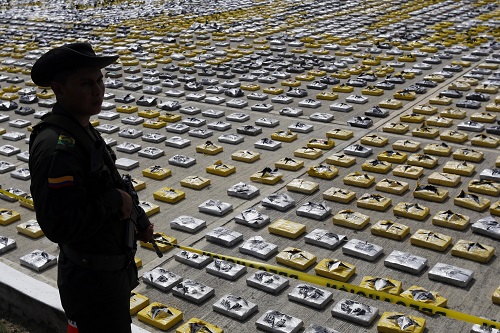AP photo
By
Ricardo Swire
Colombia’s Caribbean region extends from the Gulf of Uraba to the Gulf of Venezuela. Ports of Barranquilla and Cartagena are two key Atlantic port cities that straddle the coast. Barbados’ Bridgetown Port is simply nine hundred and forty-nine nautical miles, east-north-east of the Port Cartagena. On Wednesday March 2, 2016 Royal Barbados Police Force (RBPF) Drug Squad Detectives acting on shared intelligence seized a sizeable consignment of waterborne drugs in Carlisle Bay/Browns Beach, a public coastal area in proximity to the Bridgetown Port.
One hundred and twenty-two point nine kilos of cocaine worth US$6 million and nine point four kilos of marijuana valued US$375,000 were intercepted. Two male traffickers, a Barbadian and Guyanese, detained at the scene. Guyana sits one thousand and fifty-four nautical miles east of Port Cartagena, Colombia. The May 2017 US Department of State’s International Narcotics Control Strategy Report (INCSR) informed that “traffickers are attracted by the country’s poorly monitored ports, remote airstrips, intricate river networks, porous land borders and weak security sector capacity.”
Officials in Georgetown capitalized on US Caribbean Basin Security Initiative (CBSI) funding and established a multi-agency CCP Port Control Unit, based at John Fernandez Wharf, Guyana’s most active maritime facility. By April 2016 the special local law enforcement team intercepted forty-eight kilos of cocaine. Colombia’s underworld accommodates legendary characters known for drugs trafficking expertise, violence, extortion rackets, money laundering and murder-for-profit. Colombia’s four original drugs trafficking Cartels introduced a new social class to the country.
Latin America’s fifth largest economy touted the highest kidnapping rates globally. Approximately three million illegal pistols and revolvers circulate among forty-eight point six five million Colombians. Drugs and firearms trafficking are directly related to the regional security threats. Guns fuel conflict and profits fuel everything else. Caribbean internal security intelligence officials surmise that since 2000 Washington spent over US$10 million modifying Colombia’s internal security machinery, probing its drugs trade and criminal networks.
America’s decision makers gave US$3.5 billion to “Plan Colombia,” the third highest amount of foreign aid received by a single country worldwide. The Colombian government assigned specially trained and equipped National Police Brigades to probe egregious crimes committed in Cali. Verification of law-breakers’ identities increased from three to eighteen percent. In 2016 Colombia registered a twenty-four point one per hundred thousand citizen murder rate the lowest since 1974. Valle de Cauca is regarded Colombia’s most violent district as Urabenos devotees battle Rastrojos members for territorial supremacy.
In Antioquia, Caqueta, Meta and Guajira provinces notorious drug Capos own large swathes of land. Self-help with the one hundred and twenty-five kilos of coca needed to make one kilo of “A Grade” cocaine. A domestic drug lab’s production averages US$137.50. After a three-step scientific transformation from coca leaves to coca paste, then coca base ultimately cocaine, the value increases to US$2,269. Caribbean internal security intelligence officials recount the Wednesday November 02nd 2016 capture of a drugs baron called “Camilo.” As part of his plea bargain Camilo shared critical insight about Colombia’s clandestine drugs trafficking community.
The narco-trafficker admitted he was contracted by the Urabenos Cartel and other Traffickers as a “Shipment Coordinator,” to distribute cocaine consignments exclusively to America and Europe. His specialist skills generated between US$200,000 and US$230,000 monthly. Secretly recruited logistical operators in Colombia’s Customs department provided Camilo with real-time data on shipping containers’ departure dates, destinations, vessels and routes. Records reflect one scenario when the Colombian trafficker paid US$1.1 million to release eight hundred and twenty kilos of cocaine, seized in Port of Cartagena by Colombian Federal Police anti-narcotics officers.
The law enforcers gave Camilo a dead-line of five days to pay. Caribbean internal security intelligence analysts reflect on the probe that started four years ago by US Immigration & Customs Enforcement (ICE), US Homeland Security Investigations (HSI), Cartagena’s Assistant Attaché Office and Colombia Naval Command Special Forces’ Naval Intelligence Unit. The multi-agency investigation identified a powerful, innovative Colombian Drug Trafficking Organization (DTO) that utilized “parasitic devices attached to the hulls of cargo vessels,” for cocaine movements to North America and Europe.
The DTO possessed confidential and privileged information on Port of Cartagena berthed cargo vessels’ routes, arrival and departure times. Camilo’s scuba divers able to attach the cocaine filled underwater devices or “torpedoes” to selected ship hulls unchallenged. The Colombian Narco demonstrated unique ability to warehouse large volumes of cocaine. On one occasion a Panamanian counter-narcotics multi-ton cocaine seizure caused market price to temporarily drop. At the time one kilo valued US$4,500. The law enforcement interruption delayed a shipment and Camilo’s logistical wizardry was requested.
Entrenched corruption allowed rogue Colombian counter-narcotics agents to sell confiscated cocaine by the metric ton, to the point where the market was flooded. The DTO Boss confessed he was routinely appraised by rascal National Police Anti-Narcotics officers, who confirmed shipping Companies and containers transporting his cocaine consignments. Camilo received payment via a complex money laundering scheme, fronted by a chain of supermarkets. The stores received drug payments in euro then remitted Camilo in Colombian pesos. Evidence revealed that the DTO Boss routinely invested US$720,000 to dispatch half ton of cocaine from the Port of Cartagena, earning US$165,000 profit on each consignment.
Ricardo Swire
Ricardo Swire is the Principal Consultant at R-L-H Security Consultants & Business Support Services and writes on a number of important issues.



No Comments Yet!
You can be first to comment this post!